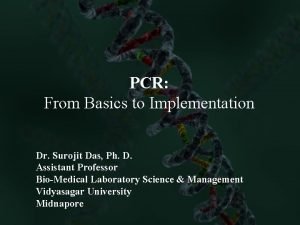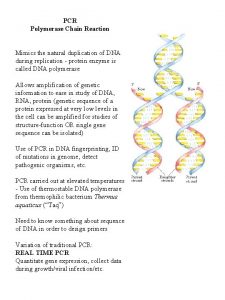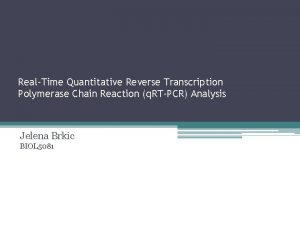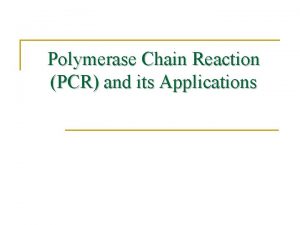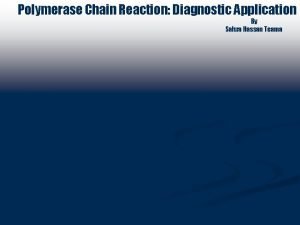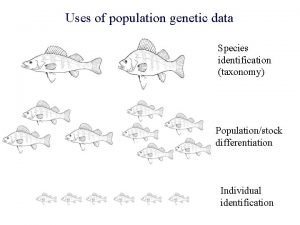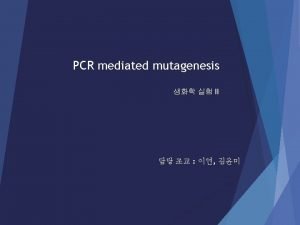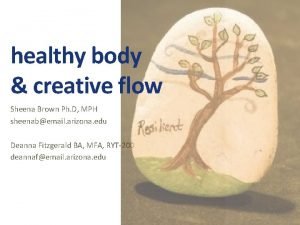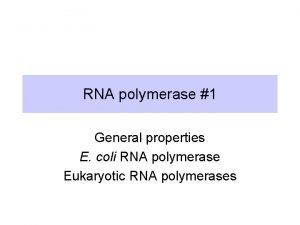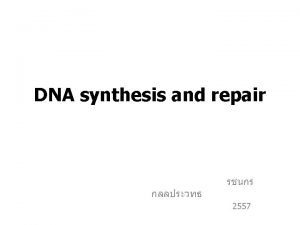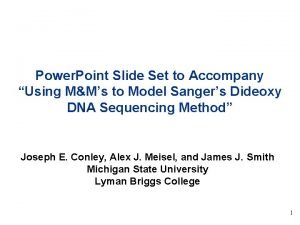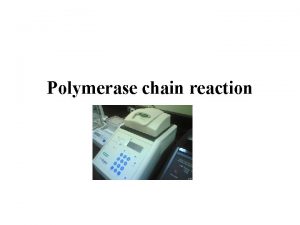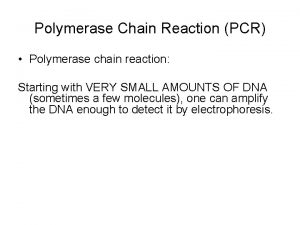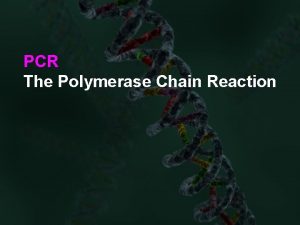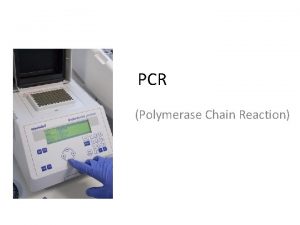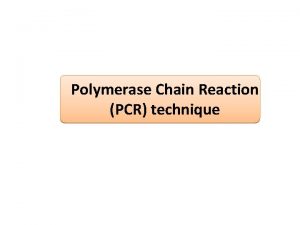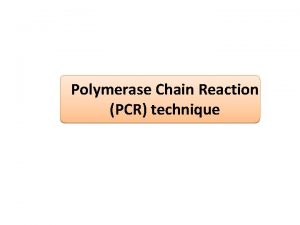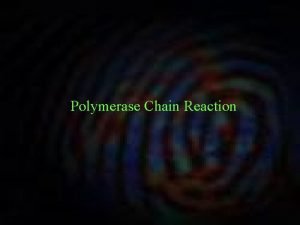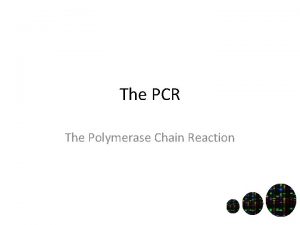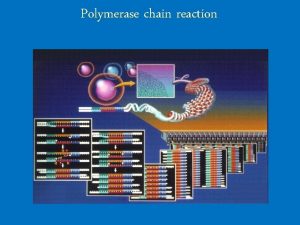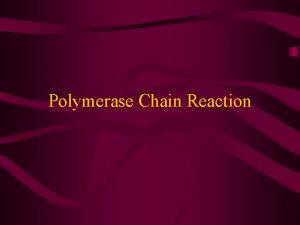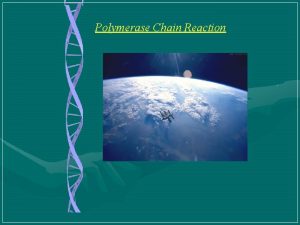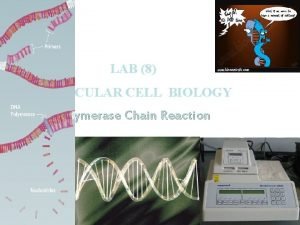Polymerase Chain Reaction Group 3 Mitika Patel Sheena





















- Slides: 21

Polymerase Chain Reaction Group 3: Mitika Patel Sheena Jain Poonum Bharal Aditi Dhakar

It is hard to exaggerate the impact of the polymerase chain reaction. PCR, the quick, easy method for generating unlimited copies of any fragment of DNA, is one of those scientific developments that actually deserves timeworn superlatives like "revolutionary" and "breakthrough. " - Tabitha M. Powledge

Purpose of PCR l l l Amplify specific nucleic acids in vitro (“Xeroxing” DNA) PCR will allow a short stretch of DNA (usually fewer than 3000 base pairs) to be amplified to about a million fold This amplified sample then allows for size determination and nucleotide sequencing Introduced in 1985 by Kary Mullis Millions of copies of a segment of DNA can be made within a few hours.

Three Steps l l l Separation: Double Stranded DNA is denatured by heat into single strands. Short Primers for DNA replication are added to the mixture. DNA polymerase catalyzes the production of complementary new strands. Copying The process is repeated for each new strand created All three steps are carried out in the same vial but at different temperatures

Step 1: Separation Combine Target Sequence, DNA primers template, d. NTPs, TAQ Polymerase l Target Sequence: Usually fewer than 3000 bp l – Identified by a specific pair of DNA primers- usually oligonucleotides that are about 20 nucleotides l Heat to 95 degrees Celsius to separate strands (for 0. 5 -2 minutes) – Longer times increase denaturation but decrease enzyme and template

Magnesium as a Cofactor l Stabilizes the reaction between: – oligonucleotides and template DNA – DNA Polymerase and template DNA

q Heat Denatures DNA by uncoiling the Double Helix strands.

Step 2: Priming l Decrease temperature by 15 -25 degrees l Primers anneal to the end of the strand l 0. 5 -2 minutes l Shorter time increases specificity but decreases yield l Requires knowledge of the base sequences of the 3’ - end


Selecting a Primer l l l l Primer length Melting Temperature (Tm) Specificity Complementary Primer Sequences G/C content and Polypyrimidine (T, C) or polypurine (A, G) stretches 3’-end Sequence Single-stranded DNA

Step 3: Polymerization Since the Taq polymerase works best at around 75 degrees C (the temperature of the hot springs where the bacterium was discovered), the temperature of the vial is raised to 72 -75 Degrees Celsius l The DNA polymerase recognizes the primer and makes a complementary copy of the template which is now single stranded. l Approximately 150 nucleotides/sec l

Potential Problems with Taq Lack of proof-reading of newly synthesized DNA. l Potentially can include di. Nucleotriphosphates (d. NTPs) that are not complementary to the original strand. l Errors in coding result l Recently discovered thermostable DNA polymerases, Tli and Pfu, are less efficient, yet highly accurate. l

Amplification


PCR Applications l Detection of infectious diseases l Detection of variations and mutations in genes l Detection of diseases from the past l PCR and the law

Detection of infectious diseases - AIDS Virus - Otitis Media-middle ear infection - Lyme Disease-joint inflammation from tick bites - Detect 3 sexually transmitted diseases in one swab-herpes, papillomarvirus, chlamydia -Test to see if mother and baby have compatible blood group-saves lives of babies

Detection of Variations and Mutations in Genes l Detects people with inherited disorders l Lets us know who carries deleterious variations (mutations) l Direct way of distinguishing among the confusion of different mutations in a single gene. Ex: Duchenne muscular dystrophy l Track presence or absence of DNA abnormalities characteristic to cancer

Detection of diseases from the past l Presidential candidate Humphreys-had cancer l John Dalton-was colored blind and realized that this was the case because he lacked a gene for one of the three photopigments, which caused him to be color blind

PCR and the Law l DNA fingerprinting – Can multiply small amounts of DNA found in blood samples, hair, semen, and other body fluids l Proving innocence of those already convicted – Kirk Bloodsworth-wrongly accused of raping and murdering a nine year old. Using PCR, he was proved innocent and released from prison in 1993

Future of PCR: l Copying larger pieces of DNA l Miniaturization of hardware (chip-sized devices) l Computer automated test and analysis l Taking PCR on the road and getting on the spot DNA analysis l Diagnose infection or genetic disorder right in the doctors office

References l l l l “Polymerase Chain Reaction-Xeroxing DNA” http: //www. accessexcellence. org/AB/IE/PCR_Xeroxing_DNA. html “The Polymerase Chain Reaction” http: //avery. rutgers. edu/WSSP/Student. Scholars/project/archives/onions/pcr. html “Polymerase Chain reaction” http: //www. tulane. edu/~wiser/methods/handouts/pcr. PDF Diagrams from : http: //allserv. rug. ac. be/~avierstr/principles/pcrani. html Purves, Sadava, Orians, Heller. “Life. ” 6 th ed. Sinauer Associates, 2001. “Mechanism of PCR. ” http: //usitweb. shef. ac. uk/~mba 97 cmh/tutorial/pcr. htm “The polymerase Chain Reaction”www. faseb. org/opar/bloodsupply/pcr. html
 Sheena kotecha
Sheena kotecha Sheena patel md
Sheena patel md Fluidigm
Fluidigm Polymerase chain reaction
Polymerase chain reaction Polymerase chain reaction
Polymerase chain reaction Applications of pcr
Applications of pcr Pcr phases
Pcr phases Polymerase chain reaction
Polymerase chain reaction The three steps of polymerase chain reaction
The three steps of polymerase chain reaction Sheena wagstaff wikipedia
Sheena wagstaff wikipedia Sheena brown
Sheena brown Sheena brown
Sheena brown Sheena iyengar ted talk
Sheena iyengar ted talk Food chain sequence
Food chain sequence Rna polymerase 1 2 3
Rna polymerase 1 2 3 Ligation
Ligation Dna prokaryot
Dna prokaryot Replication
Replication Helicaee
Helicaee How many dna polymerase in eukaryotes
How many dna polymerase in eukaryotes Types of dna polymerase in eukaryotes
Types of dna polymerase in eukaryotes Dna polymerase
Dna polymerase


